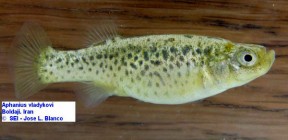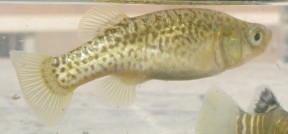Esmaeilius vladykovi
Zagros Toothcarp
SynonymsTop ↑
Aphanius vladykovi Coad, 1988
Etymology
Esmaeilius: named for Iranian ichthyologist Hamid Reza Esmaeili “for his extensive contribution to the understanding of diversity within this genus”, in combination with the Latin suffix -ius, indicating ‘belonging to’.
vladykovi: named for Ukrainian ichthyologist Vadim D. Vladykov (1898-1986) who “worked in Iran on the fisheries of the Caspian Sea basin, collected extensive material there and accepted the author as his graduate student to study those specimens”.
Classification
Order: Cyprinodontiformes Family: Aphaniidae
Distribution
Restricted to a small area of the Zagros mountain range in Chahārmahāl o Bakhtiyārī province, Iran. The type locality is close to the town of Boldaji in the upper Karun River basin and it has been recorded from nearby wetlands at Chagha Khur and Gandoman plus a few other localities in the region. Some aspects of its distribution remain unclear but it is thought to occur in the upper Khersan River within the Karun drainage as well as the upper Marun River, a tributary of the Karun that also arises in the Zagros.
Habitat
This species‘ natural waters lie over 2000m above sea level (the type locality is an artificially-dammed pool at 2380m). It inhabits slow-moving freshwater streams, pools and marshes which tend to have substrates of mud and pebbles with often quite turbid water. Aquatic plants such as Myriophyllum or Potamogeton species grow in areas where the fish can be found.
Maximum Standard Length
50 – 60 mm.
Aquarium SizeTop ↑
A pair or trio can be kept in a container with base dimensions of 60 cm x 30 cm or so but as a general rule members of this genus do best when maintained as a larger group in a space measuring upwards of 120 ∗ 30 cm.
Maintenance
Even for long-term maintenance a simple set-up will suffice. The most important factors are the provision of many broken lines of sight and a suitable medium in which the fish can deposit eggs. Female and subdominant male individuals must be offered the opportunity of respite from the aggressive alpha males during the spawning season so much of the available space can be filled with acrylic wool mops (use a fine grade if available), clumps of java moss or Ceratophyllum and ideally filamentous algae.
There’s no need to add a substrate although inert sand or gravel can be added if you preferand filtration need not be too strong either. It is possible, and preferable, to maintain it outdoors all year round in many countries and it will show better colours and overall condition if exposed to at least a few hours of natural sunlight each day.
Water Conditions
Temperature: Active over a wide temperature range of 12 – 32 °C. Ideally it should be provided with a ‘winter’ period of several months during which it is maintained at temperatures towards the lower end of this range or it is likely to suffer both reduced fecundity and a shortened lifespan.
pH: Readings taken from its habitats have varied between 6.2 – 8.5.
Hardness: Although it is tolerant of slightly more acidic conditions than most Aphanius it does not appreciate soft water. Aim for somewhere within the range 179 – 357 ppm.
Diet
Esmaeilius species are basically micropredators feeding on small aquatic crustaceans, worms, insect larvae and other zooplankton although algae and other plant material is also taken at times. In the aquarium they will learn to accept dried foods in most cases but should also be offered regular meals of small live or frozen fare such as Artemia, Daphnia or bloodworm. This is particularly important during the months of spring and summer due to their high reproductive effort throughout this period. If the aquarium or container does not contain filamentous algae try to introduce a good quality dried product with added Spirulina content to the diet.
Behaviour and CompatibilityTop ↑
Its vigorous spawning behaviour makes E. vladykovi a poor choice for the community aquarium. Given its rarity in the hobby the emphasis should be on captive reproduction and we strongly recommend maintaining it alone. It should be kept in a group with a ratio of two or three females to each male being the ideal. Males are relatively peaceful towards one another compared with some congeners and it is found swimming in large schools in nature.
Sexual Dimorphism
As with all members of the genus sexual dimorphism is pronounced. Males exhibit a series of blue vertical bars in the rear portion of the body. The dorsal fin has a light blue marginal band and another thin band towards the base but is otherwise dark blue/black. The overall body colour is noticeably more yellowish than in females. Females are larger and much plainer possessing only a series of variable dark spots on the body and almost colourless finnage.
Reproduction
Captive reproduction is not difficult if the tank or container is properly arranged and maintained (see ‘tank set-up’). It is a fractional spawner with females depositing eggs on a more-or-less continuous basis between the months of March and June in Iran. Males form temporary territories which they defend against rivals while attempting to entice females to spawn. Dominant individuals will show more intense colouration. Eggs are released singly or in small batches and are attached to algae or other surfaces by means of small filaments. Esmaeilius typically eat their eggs/fry and the medium should therefore be checked on a daily basis during the spawning period.
The eggs are very small and must be treated carefully. Use a fine pair of forceps to gently remove pieces of medium with eggs attached whilst avoiding contact with the eggs themselves. Alternatively the entire medium can be removed and replaced every couple of days. The medium/eggs should be transferred to a container with water of the same chemistry and temperature as that of the adults. The incubation period can vary a little with the temperature but is usually between 7 – 14 days with the fry being large enough to accept Artemia nauplii, microworm etc. immediately after they become free-swimming.
NotesTop ↑
The Iranian Plateau is home to a diverse group of endemic toothcarps, with four species already described and several awaiting description. These are among the most ancient in the genus having divereged away from a common ancestor around 20 – 24 million years ago. Among them this species is most closely related to A. sophiae from the Kor River system but can be distinguished by differences in patterning. Males of A. sophiae lack the characteristic dark dorsal fin colouration seen in A. vladykovi and females possess a dark, lozenge-shaped spot at the caudal peduncle which is absent in those of vladykovi.
You’re unlikely to find it on sale in aquatic stores although it may be available via specialist breeders or associations from time-to-time. While Aphanius are certainly not as colourful as some of their relatives their interesting behaviour and continuous activity make them fascinating aquarium subjects and well worth a try if you possess the dedication to take on a long-term maintenance project since conservation is key with all members of the genus.
It currently contains 22 species and subspecies which are thought to have derived from a common ancestor originally distributed around the periphery of the former Tethys Sea. None are particularly well-documented in aquarium literature although some are very beautiful and the majority are not too difficult to maintain and breed. Sadly most are on the verge of extinction for one reason or another with several existing only in remnant, highly-localised populations.
In practically all cases the root cause for this decline is the activity of humans and although some species are now protected by conservation law the mismanagement and degradation of their habitats continues at an alarming rate. A few species are still sometimes listed as members of Lebias although that name has long been considered a synonym of Cyprinodon by most authorities and an ICZN committee voted to suppress the name in favour of Aphanius as recently as 2003.
References
- Coad, B. W., 1988 - Environmental Biology of Fishes 23(1-2): 115-125
Aphanius vladykovi, a new species of tooth-carp from the Zagros Mountains of Iran (Osteichthyes: Cyprinodontidae). - Hrbek, T. and A. Meyer. 2003, 2003 - Journal of Evolutionary Biology 16(1): 17-36
Closing of the Tethys Sea and the phylogeny of Eurasian killifishes (Cyprinodontiformes: Cyprinodontidae). - Keivany, Y. and N. M. Soofiani, 2004 - Environmental Biology of Fishes 71: 165-169
Contribution to the biology of Zagros tooth-carp, Aphanius vladykovi (Cyprinodontidae) in Central Iran.





